Soil Microbial Communities Responses to Multiple Generations’ Successive Planting of Eucalyptus Trees
Abstract
:1. Introduction
2. Materials and Methods
2.1. Overview of the Research Area
2.2. Experimental Design and Soil Sample Collection
2.3. Methods for the Determination of Soil Physicochemical Properties
2.4. Measurement of Enzyme Activity
2.5. DNA Extraction and Sequencing of Soil Bacteria and Fungi
2.6. Data Processing and Statistical Analysis
3. Results
3.1. Soil Physical and Chemical Properties
3.2. Soil Enzyme Activity
3.3. The Composition of the Soil Microbiota
3.4. Soil Bacterial and Fungal Alpha Diversity
3.5. Relationships between the SPPs and Microbiota
4. Discussion
4.1. Response of SPPs to Multiple Generations of Successive Planting
4.2. Multiple Generations of Successive Planting Reduced Soil Enzyme Activity
4.3. Differences in the Diversity and Structure of Soil Bacterial and Fungal Communities across Generations of Regenerated Stands
4.4. Factors Affecting the Soil Microbiota during Successive Multigenerational Planting
5. Conclusions
Supplementary Materials
Author Contributions
Funding
Data Availability Statement
Acknowledgments
Conflicts of Interest
References
- Zhang, P.; Pang, S.; Yang, B.; Liu, S.; Jia, H.; Chen, J.; Guo, D. Effects of different mixing patterns on growth, litter production and soil nutrients in Eucalyptus plantations. J. Northwest Sci-Tech Univ. Agric. For. (Nat. Sci. Ed.) 2021, 49, 31–37. [Google Scholar]
- de Moraes Goncalves, J.L.; Alvares, C.A.; Higa, A.R.; Silva, L.D.; Alfenas, A.C.; Stahl, J.; de Barros Ferraz, S.F.; Lima, W.d.P.; Santin Brancalion, P.H.; Hubner, A.; et al. Integrating genetic and silvicultural strategies to minimize abiotic and biotic constraints in Brazilian eucalypt plantations. For. Ecol. Manag. 2013, 301, 6–27. [Google Scholar] [CrossRef]
- Wang, T.; Dai, Q.; Fu, Y.; Wei, P. Effect of continuous planting on tree growth traits and growth stress in plantation forests of Eucalyptus urophylla × E. grandis. Sustainability 2023, 15, 9624. [Google Scholar] [CrossRef]
- Asante, P.; Armstrong, G.W.; Adamowicz, W.L. Carbon sequestration and the optimal forest harvest decision: A dynamic programming approach considering biomass and dead organic matter. J. For. Econ. 2011, 17, 3–17. [Google Scholar] [CrossRef]
- Iovieno, P.; Alfani, A.; Baath, E. Soil microbial community structure and biomass as affected by Pinus pinea plantation in two Mediterranean areas. Appl. Soil Ecol. 2010, 45, 56–63. [Google Scholar] [CrossRef]
- Luo, G.; Rensing, C.; Chen, H.; Liu, M.; Wang, M.; Guo, S.; Ling, N.; Shen, Q. Deciphering the associations between soil microbial diversity and ecosystem multifunctionality driven by long-term fertilization management. Funct. Ecol. 2018, 32, 1103–1116. [Google Scholar] [CrossRef]
- Liu, J.; Wazir, Z.G.; Hou, G.-Q.; Wang, G.-Z.; Rong, F.-X.; Xu, Y.-Z.; Liu, K.; Li, M.-Y.; Liu, A.-J.; Liu, H.-L. The dependent correlation between soil multifunctionality and bacterial community across different farmland soils. Front. Microbiol. 2023, 14, 1144823. [Google Scholar] [CrossRef]
- Li, J.; Delgado-Baquerizo, M.; Wang, J.-T.; Hu, H.-W.; Cai, Z.-J.; Zhu, Y.-N.; Singh, B.K. Fungal richness contributes to multifunctionality in boreal forest soil. Soil Biol. Biochem. 2019, 136, 107526. [Google Scholar] [CrossRef]
- Ma, L.; Guo, C.; Lu, X.; Yuan, S.; Wang, R. Soil moisture and land use are major determinants of soil microbial community composition and biomass at a regional scale in northeastern China. Biogeosciences 2015, 12, 2585–2596. [Google Scholar] [CrossRef]
- Fierer, N.; Jackson, R.B. The diversity and biogeography of soil bacterial communities. Proc. Natl. Acad. Sci. USA 2006, 103, 626–631. [Google Scholar] [CrossRef]
- Wang, C.; Xue, L.; Dong, Y.; Jiao, R. Effects of stand density on soil microbial community composition and enzyme activities in subtropical Cunninghamia lanceolate (Lamb.) Hook plantations. For. Ecol. Manag. 2021, 479, 118559. [Google Scholar] [CrossRef]
- Bahram, M.; Hildebrand, F.; Forslund, S.K.; Anderson, J.L.; Soudzilovskaia, N.A.; Bodegom, P.M.; Bengtsson-Palme, J.; Anslan, S.; Coelho, L.P.; Harend, H.; et al. Structure and function of the global topsoil microbiome. Nature 2018, 560, 233–237. [Google Scholar] [CrossRef]
- Lu, X.; Hu, H.; Sun, L. Effect of fire disturbance on active organic carbon of Larix gmelinii forest soil in Northeastern China. J. For. Res. 2017, 28, 763–774. [Google Scholar] [CrossRef]
- Zhang, J.; Wang, S.; Feng, Z.; Wang, Q. Stability of soil organic carbon changes in successive rotations of Chinese fir (Cunninghamia lanceolata (Lamb.) Hook) plantations. J. Environ. Sci. 2009, 21, 352–359. [Google Scholar] [CrossRef]
- Zhang, Y.; Su, X.; Cong, J.; Lu, H.; Liu, M. The characteristics of soil organic carbon and soil microbial community structure in two deciduous broadleaved forest types. Chin. J. Soil Sci. 2014, 45, 625–629. [Google Scholar]
- Jia, X.; Zhong, Y.; Liu, J.; Zhu, G.; Shangguan, Z.; Yan, W. Effects of nitrogen enrichment on soil microbial characteristics: From biomass to enzyme activities. Geoderma 2020, 366, 114256. [Google Scholar] [CrossRef]
- Adetunji, A.T.; Lewu, F.B.; Mulidzi, R.; Ncube, B. The biological activities of β-glucosidase, phosphatase and urease as soil quality indicators: A review. J. Soil Sci. Plant Nutr. 2017, 17, 794–807. [Google Scholar] [CrossRef]
- Trivedi, P.; Delgado-Baquerizo, M.; Trivedi, C.; Hu, H.; Anderson, I.C.; Jeffries, T.C.; Zhou, J.; Singh, B.K. Microbial regulation of the soil carbon cycle: Evidence from gene-enzyme relationships. ISME J. 2016, 10, 2593–2604. [Google Scholar] [CrossRef]
- de Mesquita, C.P.B.; Knelman, J.E.; King, A.J.; Farrer, E.C.; Porazinska, D.L.; Schmidt, S.K.; Suding, K.N. Plant colonization of moss-dominated soils in the alpine: Microbial and biogeochemical implications. Soil Biol. Biochem. 2017, 111, 135–142. [Google Scholar] [CrossRef]
- Zhu, L.; Wang, X.; Chen, F.; Li, C.; Wu, L. Effects of the successive planting of Eucalyptus urophylla on soil bacterial and fungal community structure, diversity, microbial biomass, and enzyme activity. Land Degrad. Dev. 2019, 30, 636–646. [Google Scholar] [CrossRef]
- Tomao, A.; Antonio Bonet, J.; Castano, C.; de-Miguel, S. How does forest management affect fungal diversity and community composition? Current knowledge and future perspectives for the conservation of forest fungi. For. Ecol. Manag. 2020, 457, 117678. [Google Scholar] [CrossRef]
- Wu, Z.; Haack, S.E.; Lin, W.; Li, B.; Wu, L.; Fang, C.; Zhang, Z. Soil microbial community structure and metabolic activity of Pinus elliottii plantations across different stand ages in a Subtropical area. PLoS ONE 2015, 10, e0135354. [Google Scholar] [CrossRef]
- Zhang, Y.; Ma, X.; Jing, R.; Ma, F.; Guo, J.; Wang, Y.; Wang, H. Effects of successive-planting poplar plantation on soil microbial community. J. Shandong Univ. (Nat. Sci.) 2019, 54, 36–46. [Google Scholar]
- Paillet, Y.; Berges, L.; Hjalten, J.; Odor, P.; Avon, C.; Bernhardt-Roemermann, M.; Bijlsma, R.-J.; De Bruyn, L.; Fuhr, M.; Grandin, U.; et al. Biodiversity Differences between Managed and Unmanaged Forests: Meta-Analysis of Species Richness in Europe. Conserv. Biol. 2010, 24, 101–112. [Google Scholar] [CrossRef]
- Chen, J.; Deng, Z.; Jiang, Z.; Sun, J.; Meng, F.; Zuo, X.; Wu, L.; Cao, G.; Cao, S. Variations of rhizosphere and bulk soil microbial community in successive planting of Chinese fir (Cunninghamia lanceolata). Front. Plant Sci. 2022, 13, 954777. [Google Scholar] [CrossRef]
- Dai, Q.; Wang, T.; Wei, P.; Fu, Y. Effects of successive planting of Eucalyptus plantations on tree growth and soil quality. Sustainability 2023, 15, 6746. [Google Scholar] [CrossRef]
- de Vries, F.T.; Griffiths, R.I.; Bailey, M.; Craig, H.; Girlanda, M.; Gweon, H.S.; Hallin, S.; Kaisermann, A.; Keith, A.M.; Kretzschmar, M.; et al. Soil bacterial networks are less stable under drought than fungal networks. Nat. Commun. 2018, 9, 3033. [Google Scholar] [CrossRef]
- Li, H.; Yang, S.; Semenov, M.V.; Yao, F.; Ye, J.; Bu, R.; Ma, R.; Lin, J.; Kurganova, I.; Wang, X.; et al. Temperature sensitivity of SOM decomposition is linked with a K-selected microbial community. Glob. Change Biol. 2021, 27, 2763–2779. [Google Scholar] [CrossRef] [PubMed]
- Jatoi, M.T.; Lan, G.; Wu, Z.; Sun, R.; Yang, C.; Tan, Z. Comparison of soil microbial composition and diversity between mixed and monoculture rubber plantations in Hainan Province, China. Trop. Conserv. Sci. 2019, 12, 1–9. [Google Scholar] [CrossRef]
- Reijonen, I.; Metzler, M.; Hartikainen, H. Impact of soil pH and organic matter on the chemical bioavailability of vanadium species: The underlying basis for risk assessment. Environ. Pollut. 2016, 210, 371–379. [Google Scholar] [CrossRef]
- Shamrikova, E.V.; Vanchikova, E.V.; Kyzyurova, E.V.; Zhangurov, E.V. Methods for Measuring Organic Carbon Content in Carbonate-Containing Soils: A Review. Eurasian Soil Sci. 2024, 57, 380–394. [Google Scholar] [CrossRef]
- Tsiknia, M.; Tzanakakis, V.A.; Oikonomidis, D.; Paranychianakis, N.V.; Nikolaidis, N.P. Effects of olive mill wastewater on soil carbon and nitrogen cycling. Appl. Microbiol. Biotechnol. 2014, 98, 2739–2749. [Google Scholar] [CrossRef] [PubMed]
- Wu, H.; Li, Y.; Zhang, J.; Niu, L.; Zhang, W.; Cai, W.; Zhu, X. Sediment bacterial communities in a eutrophic lake influenced by multiple inflow-rivers. Environ. Sci. Pollut. Res. 2017, 24, 19795–19806. [Google Scholar] [CrossRef] [PubMed]
- Ghani, A.; Dexter, M.; Perrott, K.W. Hot-water extractable carbon in soils: A sensitive measurement for determining impacts of fertilisation, grazing and cultivation. Soil Biol. Biochem. 2003, 35, 1231–1243. [Google Scholar] [CrossRef]
- Zhou, W.; Wu, H.; Zhang, Y.; Xu, M.; Muhammad, A.; Wen, S. Improvement of Determination Method for Soil Labile Organic Carbon. Chin. J. Soil Sci. 2019, 50, 70–75. [Google Scholar]
- Brookes, P.C.; Landman, A.; Pruden, G.; Jenkinson, D.S. Chloroform fumigation and the release of soil nitrogen: A rapid direct extraction method to measure microbial biomass nitrogen in soil. Soil Biol. Biochem. 1985, 17, 837–842. [Google Scholar] [CrossRef]
- Kudeyarov, V.N.; Jenkinson, D.S. The effects of biocidal treatments on metabolism in soil—VI. Fumigation with carbon disulphide. Soil Biol. Biochem. 1976, 8, 375–378. [Google Scholar] [CrossRef]
- Bell, C.W.; Fricks, B.E.; Rocca, J.D.; Steinweg, J.M.; McMahon, S.K.; Wallenstein, M.D. High-throughput fluorometric measurement of potential soil extracellular enzyme activities. J. Vis. Exp. 2013, 81, e50961. [Google Scholar]
- Wang, C.; Lu, X.; Mori, T.; Mao, Q.; Zhou, K.; Zhou, G.; Nie, Y.; Mo, J. Responses of soil microbial community to continuous experimental nitrogen additions for 13 years in a nitrogen-rich tropical forest. Soil Biol. Biochem. 2018, 121, 103–112. [Google Scholar] [CrossRef]
- Bu, J.; Zou, J.; Zhang, X.; Xu, L.; Yang, F.; Sun, X. Influence of different fluorescence quench correction methods on three soil hydrolase activities analyzed by microplate fluorescence method. Chin. J. Soil Sci. 2014, 45, 660–665. [Google Scholar]
- Magoc, T.; Salzberg, S.L. FLASH: Fast length adjustment of short reads to improve genome assemblies. Bioinformatics 2011, 27, 2957–2963. [Google Scholar] [CrossRef]
- Bokulich, N.A.; Subramanian, S.; Faith, J.J.; Gevers, D.; Gordon, J.I.; Knight, R.; Mills, D.A.; Caporaso, J.G. Quality-filtering vastly improves diversity estimates from Illumina amplicon sequencing. Nat. Methods 2013, 10, 57–59. [Google Scholar] [CrossRef]
- Quast, C.; Pruesse, E.; Yilmaz, P.; Gerken, J.; Schweer, T.; Yarza, P.; Peplies, J.; Gloeckner, F.O. The SILVA ribosomal RNA gene database project: Improved data processing and web-based tools. Nucleic Acids Res. 2013, 41, D590–D596. [Google Scholar] [CrossRef]
- Nilsson, R.H.; Larsson, K.-H.; Taylor, A.F.S.; Bengtsson-Palme, J.; Jeppesen, T.S.; Schigel, D.; Kennedy, P.; Picard, K.; Gloeckner, F.O.; Tedersoo, L.; et al. The UNITE database for molecular identification of fungi: Handling dark taxa and parallel taxonomic classifications. Nucleic Acids Res. 2019, 47, D259–D264. [Google Scholar] [CrossRef]
- Edgar, R.C.; Haas, B.J.; Clemente, J.C.; Quince, C.; Knight, R. UCHIME improves sensitivity and speed of chimera detection. Bioinformatics 2011, 27, 2194–2200. [Google Scholar] [CrossRef]
- Callahan, B.J.; McMurdie, P.J.; Rosen, M.J.; Han, A.W.; Johnson, A.J.A.; Holmes, S.P. DADA2: High-resolution sample inference from Illumina amplicon data. Nat. Methods 2016, 13, 581–583. [Google Scholar] [CrossRef]
- Wang, Y.; Guo, H.; Gao, X.; Wang, J. The intratumor microbiota signatures associate with subtype, Tumor Stage, and Survival Status of Esophageal Carcinoma. Front. Oncol. 2021, 11, 754788. [Google Scholar] [CrossRef]
- Grace, J.B.; Anderson, T.M.; Smith, M.D.; Seabloom, E.; Andelman, S.J.; Meche, G.; Weiher, E.; Allain, L.K.; Jutila, H.; Sankaran, M.; et al. Does species diversity limit productivity in natural grassland communities? Ecol. Lett. 2007, 10, 680–689. [Google Scholar] [CrossRef]
- Hair, J.F.; Risher, J.J.; Sarstedt, M.; Ringle, C.M. When to use and how to report the results of PLS-SEM. Eur. Bus. Rev. 2019, 31, 2–24. [Google Scholar] [CrossRef]
- Zheng, H.; Ouyang, Z.; Xu, W.; Wang, X.; Miao, H.; Li, X.; Tian, Y. Variation of carbon storage by different reforestation types in the hilly red soil region of southern China. For. Ecol. Manag. 2008, 255, 1113–1121. [Google Scholar] [CrossRef]
- Ping, L.; Xie, Z.-Q. Effects of introducing Eucalyptus on indigenous biodiversity. Chin. J. Appl. Ecol. 2009, 20, 1765–1774. [Google Scholar]
- Tumer, J.; Lambert, M.J. Nutrient cycling in age sequences of two Eucalyptus plantation species. For. Ecol. Manag. 2008, 255, 1701–1712. [Google Scholar]
- Dawoe, E.K.; Quashie-Sam, J.S.; Oppong, S.K. Effect of land-use conversion from forest to cocoa agroforest on soil characteristics and quality of a Ferric Lixisol in lowland humid Ghana. Agrofor. Syst. 2014, 88, 87–99. [Google Scholar] [CrossRef]
- Fang, H.; Liu, K.; Li, D.; Peng, X.; Zhang, W.; Zhou, H. Long-term effects of inorganic fertilizers and organic manures on the structure of a paddy soil. Soil Tillage Res. 2021, 213, 105137. [Google Scholar] [CrossRef]
- Fan, B.; Ding, J.; Fenton, O.; Daly, K.; Chen, S.; Zhang, S.; Chen, Q. Investigation of differential levels of phosphorus fixation in dolomite and calcium carbonate amended red soil. J. Sci. Food Agric. 2022, 102, 740–749. [Google Scholar] [CrossRef] [PubMed]
- Tang, J.; Zhao, J.; Qin, Z.; Chen, L.; Song, X.; Ke, Q.; Wu, L.; Shi, Y. Structural equation model was used to evaluate the effects of soil chemical environment, fertility and enzyme activity on eucalyptus biomass. R. Soc. Open Sci. 2023, 10, 221570. [Google Scholar] [CrossRef]
- Wang, Y.; Chen, L.; Xiang, W.; Ouyang, S.; Zhang, T.; Zhang, X.; Zeng, Y.; Hu, Y.; Luo, G.; Kuzyakov, Y. Forest conversion to plantations: A meta-analysis of consequences for soil and microbial properties and functions. Glob. Change Biol. 2021, 27, 5643–5656. [Google Scholar] [CrossRef]
- Niu, X.; Sun, X.; Chen, D.; Zhang, S. Soil microorganisms, nutrients and enzyme activity of Larix kaempferi plantation under different ages in mountainous region of eastern Liaoning Province, China. Chin. J. Appl. Ecol. 2015, 26, 2663–2672. [Google Scholar]
- Li, X.-g.; Ding, C.-f.; Hua, K.; Zhang, T.-l.; Zhang, Y.-n.; Zhao, L.; Yang, Y.-r.; Liu, J.-g.; Wang, X.-x. Soil sickness of peanuts is attributable to modifications in soil microbes induced by peanut root exudates rather than to direct allelopathy. Soil Biol. Biochem. 2014, 78, 149–159. [Google Scholar] [CrossRef]
- Cipollini, D.; Rigsby, C.M.; Barto, E.K. Microbes as targets and mediators of allelopathy in plants. J. Chem. Ecol. 2012, 38, 714–727. [Google Scholar] [CrossRef]
- Zhao, H.; Zheng, W.; Zhang, S.; Gao, W.; Fan, Y. Soil microbial community variation with time and soil depth in Eurasian Steppe (Inner Mongolia, China). Ann. Microbiol. 2021, 71, 21. [Google Scholar] [CrossRef]
- Paz-Ferreiro, J.; Fu, S.; Mendez, A.; Gasco, G. Interactive effects of biochar and the earthworm Pontoscolex corethrurus on plant productivity and soil enzyme activities. J. Soils Sediments 2014, 14, 483–494. [Google Scholar] [CrossRef]
- Zhang, K.; Zheng, H.; Chen, F.L.; Ouyang, Z.Y.; Wang, Y.; Wu, Y.F.; Lan, J.; Fu, M.; Xiang, X.W. Changes in soil quality after converting Pinus to Eucalyptus plantations in southern China. Solid Earth 2015, 6, 115–123. [Google Scholar] [CrossRef]
- Wei, S.; Li, L.; Luo, X.; Tan, J.; Liu, X.; Liu, X.; Yang, S.; Cao, Q.; Huang, C. Soil enzyme activities and their relationships to soil physicochemical properties in different successive rotation plantations of Eucalyptus grandis. Chin. J. Appl. Environ. Biol. 2019, 25, 1312–1318. [Google Scholar]
- Zhen, Z.; Liu, H.; Wang, N.; Guo, L.; Meng, J.; Ding, N.; Wu, G.; Jiang, G. Effects of manure compost application on soil microbial community diversity and soil microenvironments in a temperate cropland in China. PLoS ONE 2014, 9, e108555. [Google Scholar] [CrossRef] [PubMed]
- Gu, S.; Hu, Q.; Cheng, Y.; Bai, L.; Liu, Z.; Xiao, W.; Gong, Z.; Wu, Y.; Feng, K.; Deng, Y.; et al. Application of organic fertilizer improves microbial community diversity and alters microbial network structure in tea (Camellia sinensis) plantation soils. Soil Tillage Res. 2019, 195, 104356. [Google Scholar] [CrossRef]
- Prieto, L.H.; Bertiller, M.B.; Carrera, A.L.; Olivera, N.L. Soil enzyme and microbial activities in a grazing ecosystem of Patagonian Monte, Argentina. Geoderma 2011, 162, 281–287. [Google Scholar] [CrossRef]
- Tischer, A.; Blagodatskaya, E.; Hamer, L. Extracellular enzyme activities in a tropical mountain rainforest region of southern Ecuador affected by low soil P status and land-use change. Appl. Soil Ecol. 2014, 74, 1–11. [Google Scholar] [CrossRef]
- Chen, R.; Yin, L.; Wang, X.; Chen, T.; Jia, L.; Jiang, Q.; Lyu, M.; Yao, X.; Chen, G. Mineral-associated organic carbon predicts the variations in microbial biomass and specific enzyme activities in a subtropical forest. Geoderma 2023, 439, 116671. [Google Scholar] [CrossRef]
- Guillaume, T.; Kotowska, M.M.; Hertel, D.; Knohl, A.; Krashevska, V.; Murtilaksono, K.; Scheu, S.; Kuzyakov, Y. Carbon costs and benefits of Indonesian rainforest conversion to plantations. Nat. Commun. 2018, 9, 2388. [Google Scholar] [CrossRef]
- Philippot, L.; Chenu, C.; Kappler, A.; Rillig, M.C.; Fierer, N. The interplay between microbial communities and soil properties. Nat. Rev. Microbiol. 2024, 22, 226–239. [Google Scholar] [CrossRef] [PubMed]
- Tecon, R.; Or, D. Biophysical processes supporting the diversity of microbial life in soil. Fems Microbiol. Rev. 2017, 41, 599–623. [Google Scholar] [CrossRef] [PubMed]
- Schimel, J.P. Life in dry soils: Effects of drought on soil microbial communities and processes. Annu. Rev. Ecol. Evol. Syst. 2018, 49, 409–432. [Google Scholar] [CrossRef]
- Shi, J.; Yang, L.; Liao, Y.; Li, J.; Jiao, S.; Shangguan, Z.; Deng, L. Soil labile organic carbon fractions mediate microbial community assembly processes during long-term vegetation succession in a semiarid region. iMeta 2023, 2, e142. [Google Scholar] [CrossRef] [PubMed]
- Xu, Y.; Li, C.; Zhu, W.; Wang, Z.; Wu, L.; Du, A. Effects of enrichmemt planting with native tree species on bacterial community structure and potential impact on Eucalyptus plantations in southern China. J. For. Res. 2022, 33, 1349–1363. [Google Scholar] [CrossRef]
- Tedersoo, L.; Bahram, M.; Polme, S.; Koljalg, U.; Yorou, N.S.; Wijesundera, R.; Villarreal Ruiz, L.; Vasco-Palacios, A.M.; Pham Quang, T.; Suija, A.; et al. Global diversity and geography of soil fungi. Science 2014, 346, 1256688. [Google Scholar] [CrossRef] [PubMed]
- Delgado-Baquerizo, M.; Oliverio, A.M.; Brewer, T.E.; Benavent-Gonzalez, A.; Eldridge, D.J.; Bardgett, R.D.; Maestre, F.T.; Singh, B.K.; Fierer, N. A global atlas of the dominant bacteria found in soil. Science 2018, 359, 320–325. [Google Scholar] [CrossRef] [PubMed]
- Bomberg, M.; Montonen, L.; Timonen, S. Anaerobic Eury- and Crenarchaeota inhabit ectomycorrhizas of boreal forest Scots pine. Eur. J. Soil Biol. 2010, 46, 356–364. [Google Scholar] [CrossRef]
- Barka Essaid, A.; Vatsa, P.; Sanchez, L.; Gaveau-Vaillant, N.; Jacquard, C.; Klenk, H.-P.; Clément, C.; Ouhdouch, Y.; van Wezel Gilles, P. Taxonomy, Physiology, and Natural products of Actinobacteria. Microbiol. Mol. Biol. Rev. 2015, 80, 1–43. [Google Scholar] [CrossRef]
- Liu, H.; Awasthi, M.K.; Zhang, Z.; Syed, A.; Bahkali, A.H.; Sindhu, R.; Verma, M. Microbial dynamics and nitrogen retention during sheep manure composting employing peach shell biochar. Bioresour. Technol. 2023, 386, 129555. [Google Scholar] [CrossRef]
- Guo, J.; Feng, H.; Roberge, G.; Feng, L.; Pan, C.; McNie, P.; Yu, Y. The negative effect of Chinese fir (Cunninghamia lanceolata) monoculture plantations on soil physicochemical properties, microbial biomass, fungal communities, and enzymatic activities. For. Ecol. Manag. 2022, 519, 120297. [Google Scholar] [CrossRef]
- Zhang, Z.; Pan, Y.; Liu, Y.; Li, M. High-Level diversity of basal fungal lineages and the control of fungal community assembly by stochastic processes in mangrove sediments. Appl. Environ. Microbiol. 2021, 87, e00928-21. [Google Scholar] [CrossRef]
- Shi, Y.; Qiu, L.; Guo, L.; Man, J.; Shang, B.; Pu, R.; Ou, X.; Dai, C.; Liu, P.; Yang, Y.; et al. K fertilizers reduce the accumulation of Cd in Panax notoginseng (Burk.) FH by improving the quality of themicrobial community. Front. Plant Sci. 2020, 11, 888. [Google Scholar] [CrossRef] [PubMed]
- Chen, C.; Zhang, J.; Lu, M.; Qin, C.; Chen, Y.; Yang, L.; Huang, Q.; Wang, J.; Shen, Z.; Shen, Q. Microbial communities of an arable soil treated for 8 years with organic and inorganic fertilizers. Biol. Fertil. Soils 2016, 52, 455–467. [Google Scholar] [CrossRef]
- Waldrop, M.P.; Holloway, J.M.; Smith, D.B.; Goldhaber, M.B.; Drenovsky, R.E.; Scow, K.M.; Dick, R.; Howard, D.; Wylie, B.; Grace, J.B. The interacting roles of climate, soils, and plant production on soil microbial communities at a continental scale. Ecology 2017, 98, 1957–1967. [Google Scholar] [CrossRef] [PubMed]
- Johnston, A.S.A.; Sibly, R.M. Multiple environmental controls explain global patterns in soil animal communities. Oecologia 2020, 192, 1047–1056. [Google Scholar] [CrossRef]
- Carbone, M.S.; Still, C.J.; Ambrose, A.R.; Dawson, T.E.; Williams, A.P.; Boot, C.M.; Schaeffer, S.M.; Schimel, J.P. Seasonal and episodic moisture controls on plant and microbial contributions to soil respiration. Oecologia 2011, 167, 265–278. [Google Scholar] [CrossRef]
- Davidson, E.A.; Samanta, S.; Caramori, S.S.; Savage, K. The Dual Arrhenius and Michaelis-Menten kinetics model for decomposition of soil organic matter at hourly to seasonal time scales. Glob. Change Biol. 2012, 18, 371–384. [Google Scholar] [CrossRef]
- Sul, W.J.; Asuming-Brempong, S.; Wang, Q.; Tourlousse, D.M.; Penton, C.R.; Deng, Y.; Rodrigues, J.L.M.; Adiku, S.G.K.; Jones, J.W.; Zhou, J.; et al. Tropical agricultural land management influences on soil microbial communities through its effect on soil organic carbon. Soil Biol. Biochem. 2013, 65, 33–38. [Google Scholar] [CrossRef]
- Ramirez, P.B.; Fuentes-Alburquenque, S.; Diez, B.; Vargas, I.; Bonilla, C.A. Soil microbial community responses to labile organic carbon fractions in relation to soil type and land use along a climate gradient. Soil Biol. Biochem. 2020, 141, 107692. [Google Scholar] [CrossRef]
- Zhu, D.; Liu, Y.; Chen, J.; Jiang, P. Long-term successive rotation affects soil microbial resource limitation and carbon use efficiency in Chinese fir (Cunninghamia lanceolata) monoculture plantations. For. Ecol. Manag. 2023, 540, 121037. [Google Scholar] [CrossRef]
- Fioretto, A.; Papa, S.; Pellegrino, A.; Ferrigno, A. Microbial activities in soils of a Mediterranean ecosystem in different successional stages. Soil Biol. Biochem. 2009, 41, 2061–2068. [Google Scholar] [CrossRef]
- Zhou, Y.; Staver, A.C. Enhanced activity of soil nutrient-releasing enzymes after plant invasion: A meta-analysis. Ecology 2019, 100, e02830. [Google Scholar] [CrossRef] [PubMed]
- Cui, Y.; Fang, L.; Guo, X.; Wang, X.; Zhang, Y.; Li, P.; Zhang, X. Ecoenzymatic stoichiometry and microbial nutrient limitation in rhizosphere soil in the arid area of the northern Loess Plateau, China. Soil Biol. Biochem. 2018, 116, 11–21. [Google Scholar] [CrossRef]
- Prescott, C.E.; Grayston, S.J. Tree species influence on microbial communities in litter and soil: Current knowledge and research needs. For. Ecol. Manag. 2013, 309, 19–27. [Google Scholar] [CrossRef]
- Frouz, J.; Liveckova, M.; Albrechtova, J.; Chronakova, A.; Cajthaml, T.; Pizl, V.; Hanel, L.; Stary, J.; Baldrian, P.; Lhotakova, Z.; et al. Is the effect of trees on soil properties mediated by soil fauna? A case study from post-mining sites. For. Ecol. Manag. 2013, 309, 87–95. [Google Scholar] [CrossRef]
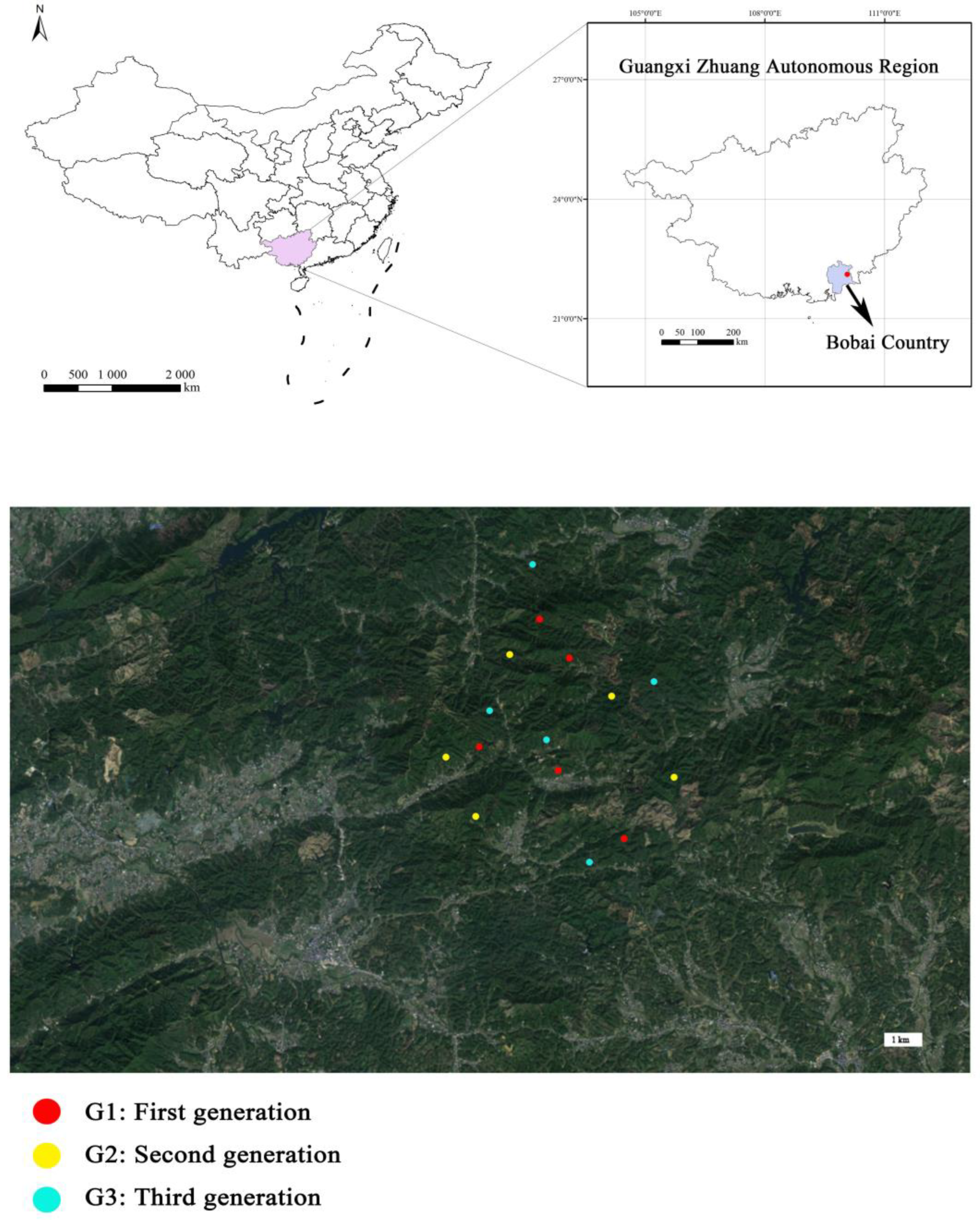


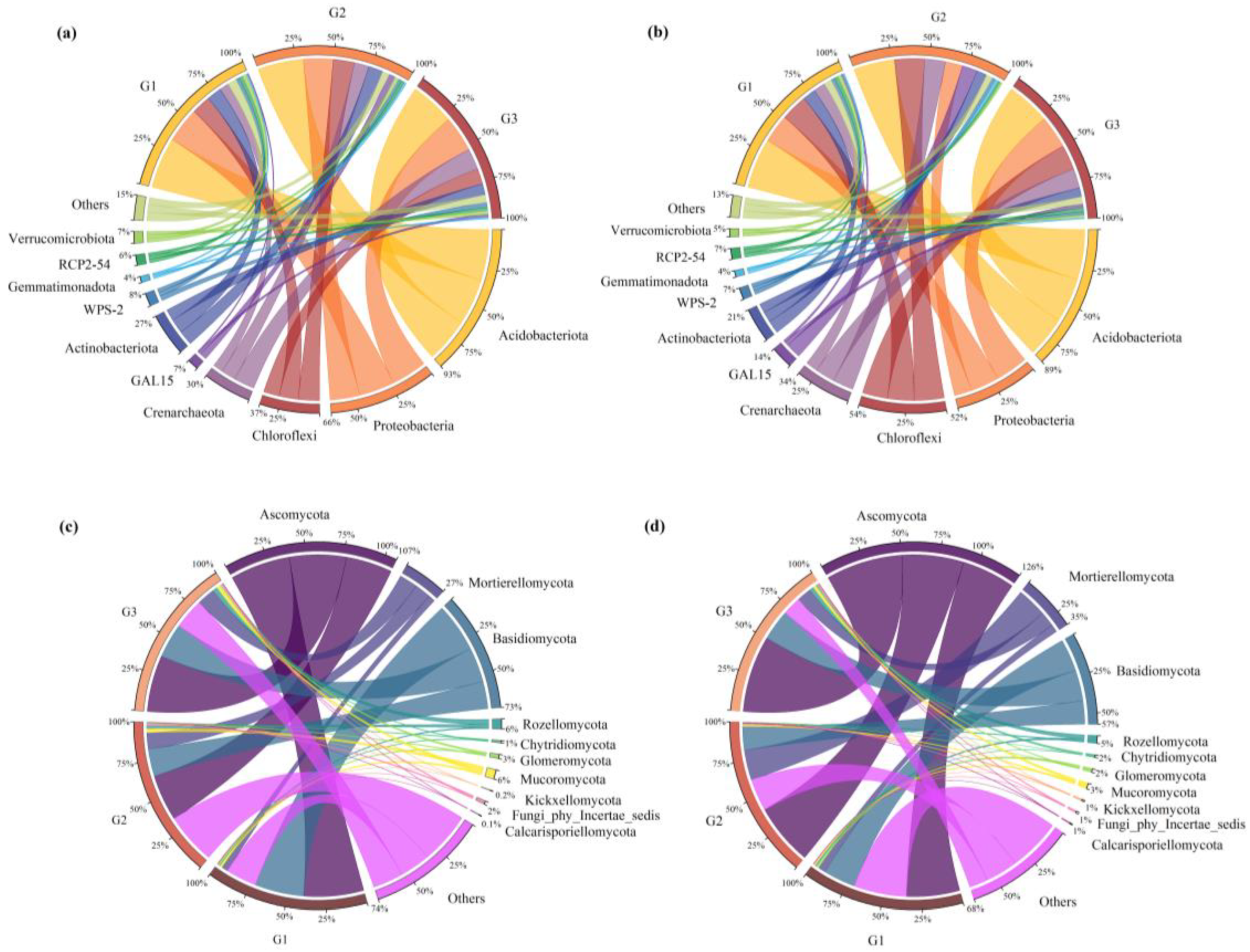

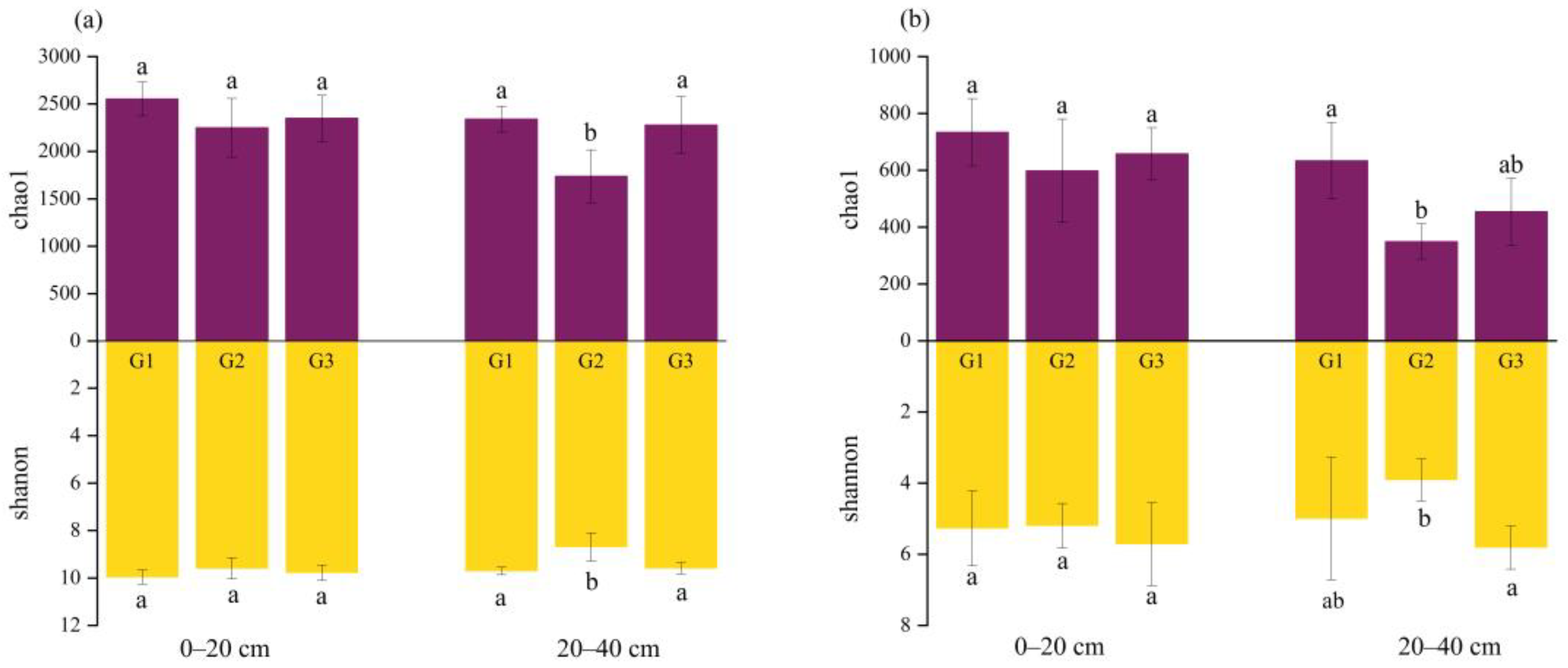
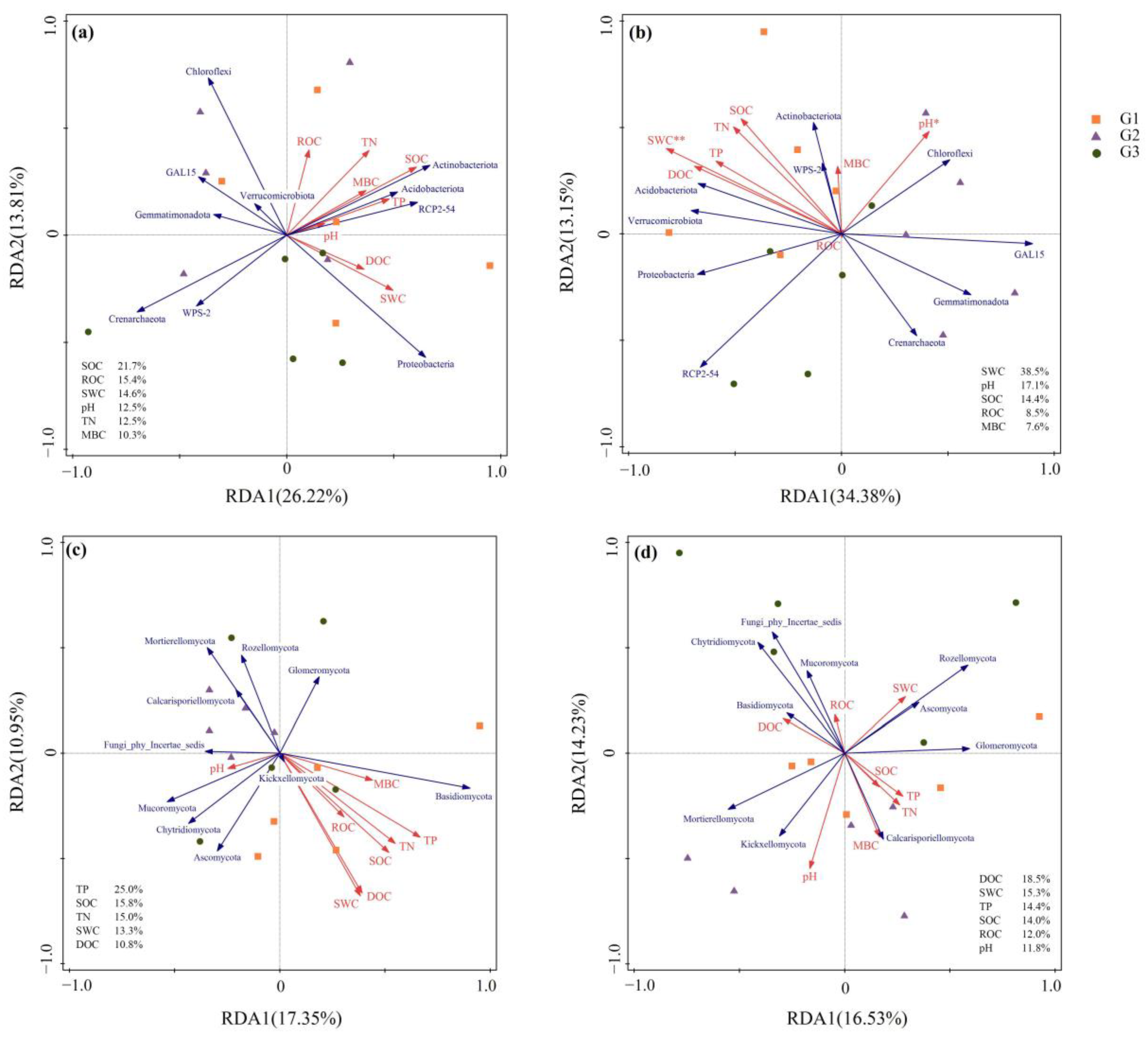
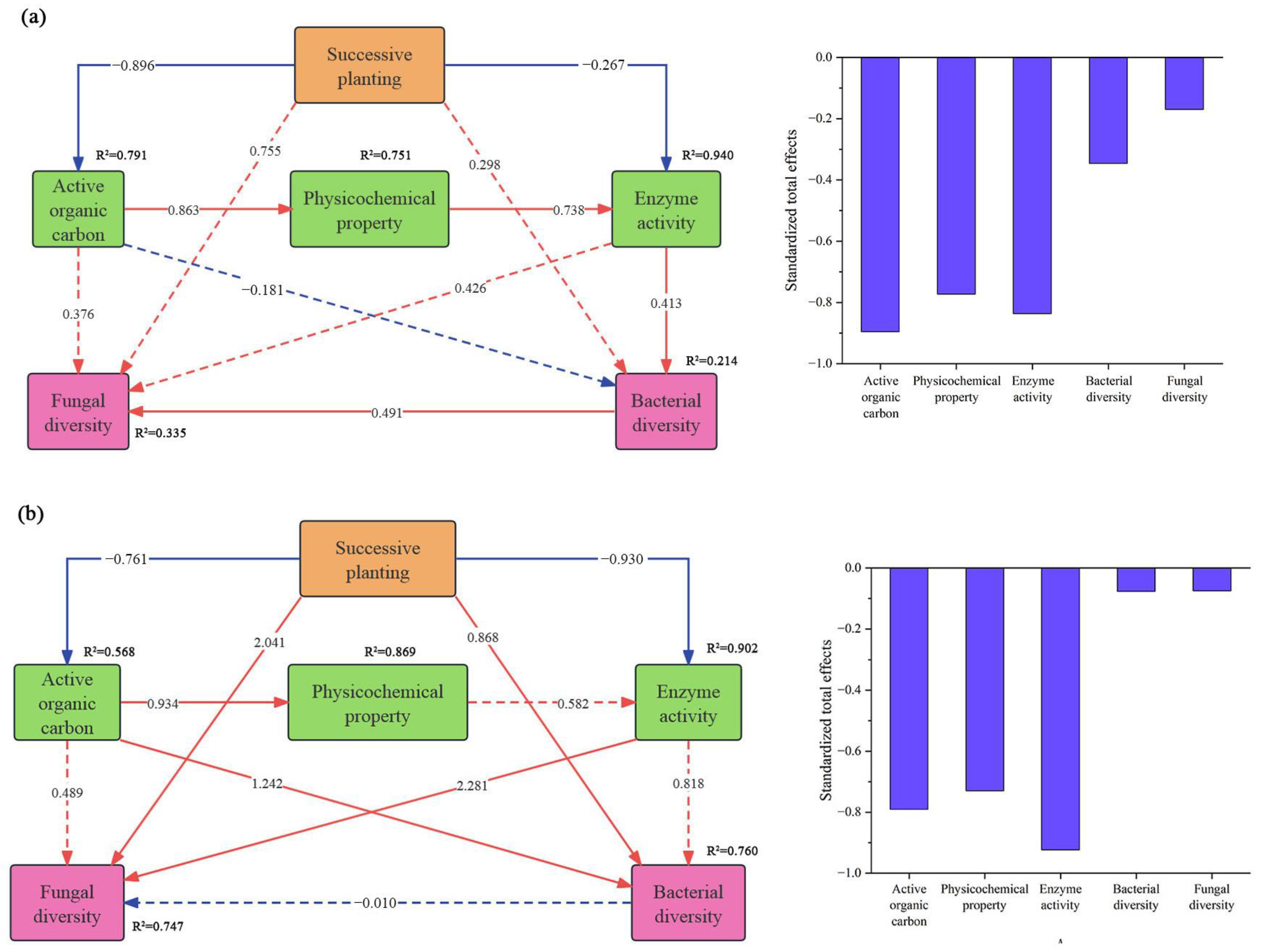
| Stand Type | Planting Pattern | Altitude (m) | Stand Age (y) | Aspect | Slope (°) | Position on Slope | Stand Area (ha) |
|---|---|---|---|---|---|---|---|
| G1 | seedling | 150 | 6 | sunny slope | 24 | middle | 13.93 |
| G2 | budding | 123 | 5 | sunny slope | 18 | middle | 18.47 |
| G3 | budding | 177 | 5 | sunny slope | 29 | middle | 27.80 |
| Generation | G1 | G2 | G3 | G1 | G2 | G3 |
|---|---|---|---|---|---|---|
| Soil Layer | 0–20 cm | 20–40 cm | ||||
| SBD g·cm−3 | 0.94 ± 0.09 b | 1.20 ± 0.04 a | 1.27 ± 0.02 a | 1.22 ± 0.13 b | 1.39 ± 0.06 a | 1.39 ± 0.09 a |
| SWC % | 21.95 ± 4.72 a | 13.14 ± 1.33 b | 15.24 ± 2.19 b | 19.44 ± 0.93 a | 12.20 ± 1.02 c | 15.04 ± 1.20 b |
| pH | 3.00 ± 0.04 a | 3.00 ± 0.04 a | 2.98 ± 0.06 a | 3.06 ± 0.06 a | 3.09 ± 0.05 a | 2.96 ± 0.08 b |
| SOC g·kg−1 | 24.73 ± 4.97 a | 16.65 ± 3.02 b | 13.97 ± 2.31 b | 11.10 ± 2.65 a | 7.23 ± 1.60 b | 6.12 ± 1.25 b |
| TN g·kg−1 | 1.83 ± 0.13 a | 0.97 ± 0.26 b | 0.92 ± 0.09 b | 1.00 ± 0.02 a | 0.54 ± 0.07 b | 0.46 ± 0.02 c |
| TP g·kg−1 | 0.33 ± 0.02 a | 0.22 ± 0.01 b | 0.24 ± 0.02 b | 0.29 ± 0.02 a | 0.21 ± 0.01 b | 0.21 ± 0.02 b |
| ROC g·kg−1 | 4.08 ± 1.65 a | 3.52 ± 1.27 a | 1.47 ± 0.76 b | 1.90 ± 1.15 b | 3.20 ± 1.68 a | 3.96 ± 0.71 a |
| DOC g·kg−1 | 1.66 ± 0.17 a | 1.33 ± 0.09 b | 1.46 ± 0.22 a b | 2.13 ± 0.33 a | 1.43 ± 0.30 b | 1.72 ± 0.14 b |
| MBC mg·kg−1 | 321.17 ± 62.77 a | 289.83 ± 79.37 ab | 227.39 ± 69.09 b | 236.39 ± 31.96 a | 219.94 ± 19.33 a | 206.44 ± 21.47 a |
| Soil Layer | Bacterial | Fungal | Bacterial | Fungal | ||||
|---|---|---|---|---|---|---|---|---|
| 0–20 cm | 20–40 cm | |||||||
| Indicator | Chao1 | Shannon | Chao1 | Shannon | Chao1 | Shannon | Chao1 | Shannon |
| pH | 0.356 | 0.219 | −0.179 | 0.157 | −0.248 | −0.297 | −0.175 | −0.387 |
| SWC | 0.875 ** | 0.575 * | 0.568 * | 0.093 | 0.596 * | 0.689 ** | 0.689 ** | 0.229 |
| SOC | 0.343 | 0.304 | 0.339 | −0.143 | 0220 | 0.247 | 0.516 * | −0.134 |
| TN | 0.390 | 0.025 | 0286 | −0.136 | 0.134 | 0.261 | 0.537 * | −0.134 |
| TP | 0.163 | 0.188 | 0.389 | 0.052 | 0.457 | 0.623 * | 0.741 ** | 0.138 |
| ROC | 0.100 | 0.046 | 0.021 | −0.214 | −0.061 | −0.075 | −0.546 * | −0.100 |
| DOC | 0.611 * | 0.379 | 0.214 | 0.021 | 0.575 * | 0.507 | 0.689 ** | 0.171 |
| MBC | 0.521 * | 0.208 | 0.405 | 0.002 | 0.131 | 0.127 | 0.160 | −0.066 |
Disclaimer/Publisher’s Note: The statements, opinions and data contained in all publications are solely those of the individual author(s) and contributor(s) and not of MDPI and/or the editor(s). MDPI and/or the editor(s) disclaim responsibility for any injury to people or property resulting from any ideas, methods, instructions or products referred to in the content. |
© 2024 by the authors. Licensee MDPI, Basel, Switzerland. This article is an open access article distributed under the terms and conditions of the Creative Commons Attribution (CC BY) license (https://creativecommons.org/licenses/by/4.0/).
Share and Cite
Jiang, C.; He, Y.; Cui, Y.; Lan, Y.; Zhang, H.; Ye, S. Soil Microbial Communities Responses to Multiple Generations’ Successive Planting of Eucalyptus Trees. Forests 2024, 15, 1166. https://doi.org/10.3390/f15071166
Jiang C, He Y, Cui Y, Lan Y, Zhang H, Ye S. Soil Microbial Communities Responses to Multiple Generations’ Successive Planting of Eucalyptus Trees. Forests. 2024; 15(7):1166. https://doi.org/10.3390/f15071166
Chicago/Turabian StyleJiang, Chenyang, Yaqin He, Yuhong Cui, Yahui Lan, Han Zhang, and Shaoming Ye. 2024. "Soil Microbial Communities Responses to Multiple Generations’ Successive Planting of Eucalyptus Trees" Forests 15, no. 7: 1166. https://doi.org/10.3390/f15071166





